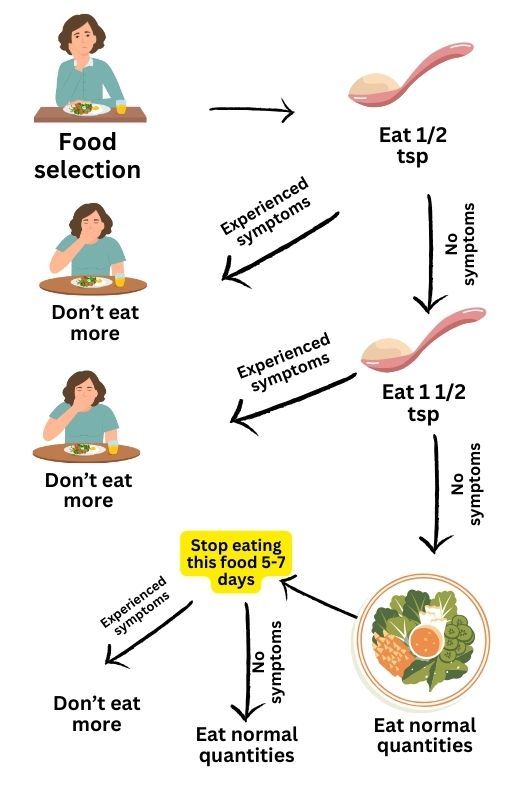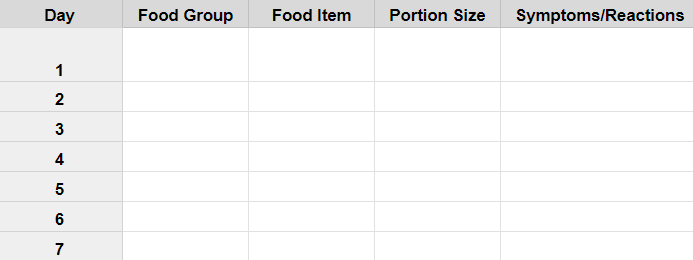Starting on the Autoimmune Protocol (AIP) diet is an important part of the AIP diet, not just for your diet, but for your overall health. Having personally tested the tricky waters of food reintroduction, I’ve experienced firsthand how critical a planned approach is. This guide aims to walk you through each step, ensuring your reintroduction phase is as smooth and informative as possible.
In this article, we will go through when to start reintroductions on the AIP elimination diet, the stages of reintroduction, and how to monitor your symptoms after eating eliminated foods.
Purpose of the AIP Reintroduction Phase
The AIP diet is a systematic approach designed to help individuals with autoimmune disorders identify food triggers and manage symptoms. It involves an initial AIP elimination phase, removing potential irritants like grains, legumes, nuts, seeds, dairy, and processed foods, followed by a careful reintroduction phase. This process helps pinpoint specific foods that might be causing an immune response or exacerbating symptoms. Here’s why it’s important:
- Identifying Intolerances: Reintroducing foods may lead to intolerance symptoms, indicating specific foods that you may be intolerant or sensitive to. This awareness helps in avoiding trigger foods and managing symptoms effectively.
- Roadmap to Intolerances: Through reintroduction, you can create a roadmap of your specific intolerances, enabling you to tailor your diet to suit your body’s needs and minimize adverse reactions.
- Reduction of Inflammation: By pinpointing allergens or inflammatory foods during reintroduction, individuals can reduce inflammation in the body. This reduction not only aids in healing but also lowers the risk of chronic illnesses and autoimmune conditions.
- Benefiting from Wider Variety of Nutrients: Reintroducing foods allows you to access a broader range of nutrients, promoting overall health and well-being by diversifying your diet with nutrient-rich options.
Benefits of Gradual Food Reintroduction
Gradually reintroducing foods allows you to monitor your body’s reaction to each food item one at a time. This method can help identify what foods are safe and which ones continue to be problematic, thereby creating a tailored diet that supports your health without triggering symptoms.
- Risk Reduction of Flare-ups: Starting the phase gradually accelerates movement through the reintroduction process, minimizing the risk of symptoms of flare-ups and adverse reactions.
- Clarity on Dietary Preferences: The AIP reintroduction process offers insight into which foods are not well-tolerated, providing a clearer picture of dietary preferences and sensitivities.
- Accurate Tracking: Properly starting the reintroduction phase facilitates more accurate tracking of autoimmune disease symptoms in case of flare-ups, aiding in pinpointing problematic foods.
- Sustainability of New Habits: Establishing new dietary habits becomes more manageable, ensuring long-term adherence to health-promoting strategies.
However, initiating the reintroduction phase is not without challenges. Overcoming barriers such as fear of returning to less restrictive diets and concerns about maintaining newfound habits is essential. Moreover, understanding the physiological implications of prolonged food avoidance is crucial. Extended avoidance can lead to heightened immune reactivity upon reintroduction, emphasizing the importance of a gradual and systematic approach to minimize adverse reactions.
Risks of Rapid Reintroduction
- Rushing the reintroduction process can lead to overwhelming the immune system, making it difficult to discern which foods are causing reactions. Such an approach not only confuses the results but may also exacerbate your symptoms, leading to setbacks in your recovery progress.
- Reintroducing foods too quickly makes it challenging to pinpoint specific triggers of adverse reactions. This can hinder your ability to identify and eliminate problematic foods from your diet effectively.
- Rapid reintroduction may exacerbate inflammation in the body, especially if you are diagnosed with an autoimmune condition or chronic inflammatory disorder. This can lead to flare-ups of symptoms and impede the healing process.
- Rapidly reintroducing foods can disrupt the delicate balance of gut microbiota, leading to dysbiosis and digestive issues. This can compromise overall gut health and contribute to long-term gastrointestinal problems.
- Rapidly reintroducing calorie-dense or highly processed foods may contribute to weight gain, especially if portion control is not practiced. This can have implications for your metabolic health and overall well-being.
- It may also have psychological consequences, such as feelings of guilt or failure if adverse reactions occur. This can negatively impact your relationship with food and their adherence to dietary protocols.
When to Reintroduce Foods on the Autoimmune Protocol (AIP)

There are no strict timelines to start reintroductions on the AIP due to the considerable variability among individuals. Factors such as disease activity, genetic predispositions, nutrient deficiencies, and lifestyle choices can influence the timing and effectiveness of reintroductions.
Determining the optimal timing for reintroducing foods on the Autoimmune Protocol (AIP) is crucial for individuals seeking to customize their diet while managing autoimmune conditions. Here’s a breakdown of key considerations and guidelines:
- Signs of Improvement
- Reintroductions may be considered after three to four weeks on the AIP if noticeable improvements in health are observed.
- These improvements serve as indicators of the protocol’s efficacy and readiness for reintroducing certain foods.
- Seeking Professional Guidance
- If significant improvements are not seen after three to four months of the Elimination Phase, consulting with an AIP Certified Coach or functional medicine doctor is advisable.
- Professional guidance can help troubleshoot challenges and optimize the reintroduction process for better outcomes.
- Keeping Detailed Records
- Maintaining a food and symptom journal during the reintroduction phase is essential.
- Recording dietary changes and corresponding reactions aids in identifying problematic foods and making informed decisions.
Important Tips Before Starting AIP Reintroduction
Starting the reintroduction phase of the Autoimmune Protocol (AIP) can be both exciting and daunting. As you prepare to reintroduce eliminated foods into your diet, it’s essential to approach this phase with careful consideration and preparation. These important tips will help you make informed decisions about your dietary choices and optimize your health journey.
- Choose Based on Preference or Safety: There’s no strict rule on where to start reintroductions. Consider starting with foods you miss the most or those least likely to cause a reaction.
- Follow a Staged Approach: Reintroductions can be divided into four stages based on tolerance likelihood and nutritional value. Stage 1 includes well-tolerated and nutrient-dense foods, while Stage 4 comprises foods most likely to cause intolerance.
- Prioritize Stage 1 Foods: Challenge all foods from Stage 1 first, excluding any you’re allergic to or have severe reactions to, before moving to Stage 2.
- Overcome Fear: Don’t let fear hold you back from reintroductions. They’re a crucial part of your health journey and can add variety and nutritional benefits to your diet.
- Empowering Knowledge: Whether reintroductions succeed or fail, they provide valuable insights into your body’s response to different foods. Success adds variety, while failure helps you understand dietary triggers and boundaries.
- Recovery is Possible: In case of a severe reaction, remember the AIP toolkit for healing. Return to 100% AIP, prioritize rest and hydration, and gradually reintroduce foods once you feel better.
- Moderate Consumption: Even after successful reintroductions, practice moderation when consuming the reintroduced food. Avoid excessive intake to maintain balance and prevent potential adverse effects.
- “Sometimes Foods”: Certain foods, although tolerated, should be categorized as “sometimes foods.” These items may not trigger immediate reactions but should be consumed sparingly to prioritize long-term health and well-being.
AIP Reintroduction Stages

The reintroduction phase of the AIP diet is segmented into several stages, each focusing on different food groups. This structured approach helps in systematically testing how each group affects your autoimmune condition.
Stage 1 Foods (Well-tolerated – nutrient-dense)
- Incorporate egg yolks into your diet, a rich source of essential nutrients.
- Experiment with fruit-, berry-, and seed-based spices to add flavor to your meals.
- Include seed and nut oils in moderation for their healthy fats.
- Introduce ghee from grass-fed dairy for its potential benefits.
- Consider occasional consumption of coffee and cocoa or chocolate, paying attention to any reactions.
- Explore peas and legumes with edible pods, such as green beans and sugar snap peas, along with legume sprouts for variety.
Stage 2 Foods (Less-tolerated – Less nutrient)
- Gradually reintroduce seeds and nuts, monitoring for any adverse reactions.
- Incorporate chia seeds into your diet for their nutritional benefits.
- Assess your tolerance to daily consumption of coffee and consider its effects on your overall well-being.
- Experiment with egg whites cautiously, noting any potential sensitivities.
- Consider adding grass-fed butter in small quantities, keeping an eye on how your body responds.
Stage 3 Foods
- Experiment with eggplant and sweet peppers, observing how they affect your symptoms.
- Introduce paprika as a seasoning, monitoring any inflammatory responses.
- Include peeled potatoes in your meals, assessing their compatibility with your body.
- Consider incorporating grass-fed dairy cautiously, noting any digestive issues or immune reactions.
- Explore lentils, split peas, and garbanzo beans as potential sources of protein, watching for any adverse effects.
Stage 4 Foods (Untolerated)
- Carefully reintroduce chili peppers and nightshade spices, paying attention to any inflammatory symptoms.
- Assess your tolerance to tomatoes and unpeeled potatoes, monitoring for any adverse reactions.
- Gradually reintroduce gluten-free grains and pseudo-grains, such as white rice, observing how they impact your symptoms.
- Experiment with traditionally prepared or fermented legumes cautiously, watching for any digestive discomfort or immune responses.
- Avoid foods you are allergic to or have a history of strong reactions to, prioritizing your health and well-being.
Reintroducing Dairy
Start with ghee or clarified butter, which has fewer proteins that commonly trigger immune responses. Monitor any changes in symptoms carefully before moving to other dairy products.
Reintroducing Gluten
Gluten reintroduction should be approached with caution, starting with low-gluten options. Observe and record any symptom flare-ups or changes in your well-being.
Reintroducing Nightshades
Begin with foods that are lower in alkaloids, such as peeled potatoes. Watch for any skin, joint, or gut reactions as these are common with nightshades.
Reintroducing Eggs
Introduce yolks first, as they are less likely to cause reactions compared to egg whites. Keep a close eye on digestive or skin responses.
Reintroducing Nuts
Start with nuts that are typically easier to digest, such as macadamias or cashews. Note any signs of gastrointestinal discomfort or fatigue.
Reintroducing Seeds
Similar to nuts, begin with seeds that are commonly less allergenic, like pumpkin seeds, and observe how your body reacts over several days.
AIP Reintroduction Process
First, select the food you wish to challenge. Be prepared to consume this food two to three times within one day, followed by completely avoiding the food for several days.
- Begin by eating a small amount, approximately half a teaspoon or even less (a tiny nibble). Wait for fifteen minutes and observe for any symptoms.
- If you do not experience any symptoms, eat one teaspoon of the food (a small bite). Wait for another fifteen minutes and monitor for symptoms.
- If no symptoms occur, eat one and a half teaspoons of the food (a slightly larger bite). Continue to wait for fifteen minutes, observing for any adverse reactions.
- After this, do not consume any more of the food for two to three hours. During this time, carefully monitor yourself for any symptoms.
- If you do not experience any symptoms after the initial observation period, you may eat a normal-sized portion of the food, either by itself or as part of a meal.
- Do not eat the challenged food again for five to seven days, and avoid reintroducing any other new foods during this period. Continue to monitor yourself for any symptoms.
- If no symptoms are experienced on the challenge day or at any time during the subsequent five to seven days, you may consider reincorporating this food into your diet.

It is advisable not to rush the food challenge process. Generally, the longer you wait to reintroduce particular foods, the higher the likelihood of success, due to potential improvements in gut and immune health. Ultimately, the timing of when to reintroduce specific foods is at your discretion.
Symptoms to Watch for During the AIP Reintroduction Phase
- Pay attention to any gastrointestinal symptoms, such as bloating, gas, diarrhea, or constipation, which may indicate intolerance to reintroduced foods.
- Watch for signs of inflammation, including joint pain, headaches, skin rashes, or swelling, which could signal a reaction to certain foods.
- Monitor your energy levels and mood for any changes, as fluctuations may indicate a response to reintroduced foods affecting your overall well-being.
- Keep track of any changes in sleep patterns or cognitive function, as these could be linked to the reintroduction of specific foods.
- Be mindful of any changes in autoimmune symptoms, such as fatigue, muscle pain, or brain fog, as these may be indicative of a negative reaction to reintroduced foods.
- Note any allergic reactions, such as itching, hives, or difficulty breathing, which require immediate medical attention and the removal of the offending food from your diet.
- Listen to your body and trust your instincts if you suspect a particular food is causing adverse effects, and consider consulting with a healthcare professional or registered dietitian for guidance and support.
- Be aware of cravings for sugar and caffeine, which may indicate a sensitivity to these substances and a potential adverse reaction upon reintroduction.
- Monitor for cravings for non-food items, a condition known as pica, which could signal a deficiency or intolerance to certain nutrients.
- Recognize any intense desires for specific foods that were eliminated during the AIP phase, as these cravings may indicate a potential reaction to reintroduced foods.
- Pay attention to the intensity and frequency of cravings, as well as any associated symptoms, to determine if they are linked to the reintroduction of certain foods.
Using the Elimination Diet Reintroduction Chart
Employing a structured approach is key to tracking and monitoring reintroduced foods. Utilizing a reintroduction chart is essential for keeping accurate records of what foods have been reintroduced, along with any symptoms or reactions. This visual tool helps you and your healthcare provider understand your food tolerances and plan further dietary adjustments.
The Elimination Diet Reintroduction Chart provides a clear framework for systematically reintroducing foods while monitoring for any adverse reactions. Each day corresponds to a specific food group and portion size, allowing for a methodical assessment of tolerance. By diligently recording any symptoms or reactions experienced after consuming each food item, individuals can gain valuable insights into their body’s responses. This organized approach fosters greater awareness and empowers individuals to make informed decisions about their dietary choices moving forward.

What is the difference between paleo AIP reintroduction and AIP reintroduction?
The primary difference between Paleo AIP reintroduction and standard AIP reintroduction lies in the specific dietary framework and the types of foods considered for reintroduction.
- Dietary Framework:
- Paleo AIP Reintroduction: This approach follows the principles of the Paleo diet, emphasizing whole, unprocessed foods that mimic those consumed by our Paleolithic ancestors. It focuses on eliminating grains, legumes, dairy, refined sugars, processed oils, and other potentially inflammatory foods.
- Standard AIP Reintroduction: The standard AIP reintroduction aligns with the Autoimmune Protocol (AIP), which encompasses the Paleo diet principles but includes additional eliminations such as nightshade vegetables, nuts, seeds, and eggs. It aims to identify and eliminate foods that may trigger or exacerbate autoimmune symptoms.
- Types of Foods Reintroduced:
- Paleo AIP Reintroduction: Foods reintroduced in the Paleo AIP protocol typically adhere to Paleo principles, such as certain nuts, seeds, non-nightshade vegetables, and potentially dairy products from grass-fed sources.
- Standard AIP Reintroduction: In the standard AIP reintroduction, a broader range of foods may be reintroduced, including those eliminated in the standard AIP phase, such as nightshade vegetables, nuts, seeds, and eggs. The reintroduction process may vary based on individual sensitivities and preferences.
Check out Why AIP Diet Doesn’t Work With You.

Frequently Asked Questions
When should I wait before starting the AIP reintroduction phase?
There are many cases where AIP reintroduction isn’t recommended or should be avoided:
- If you haven’t eliminated all food groups in the elimination phase
- If you are sick
- After intense physical activity
- Under high stress
The above circumstances may complicate symptom interpretation. Waiting until these factors subside ensures clearer insights into the body’s responses to reintroduced foods.
If I reintroduced food during the AIP reintroduction phase and experienced symptoms, does that mean that I should avoid it my whole life?
No, experiencing symptoms after reintroducing a food during the AIP reintroduction phase doesn’t necessarily mean you should avoid it for life. It could indicate a temporary sensitivity or require further experimentation with different forms or preparations.
However, the sensitivity decreases with time as the number of immune cells decreases, so it’s recommended to try reintroducing that food again in a few months. Gradual reintroduction, careful monitoring, and reassessment over time can help determine your body’s tolerance to specific foods.
My body reacted to a reintroduced food in phase one, should I stop the reintroduction phase and return to the elimination phase?
If your body reacted to a reintroduced food during phase one of the AIP (Autoimmune Protocol) reintroduction phase, it’s advisable to pause the reintroduction process and return to the elimination phase temporarily. This allows your body time to settle and symptoms to subside before considering reintroducing other foods. Once symptoms have resolved, you can resume the reintroduction process, starting with a different food and closely monitoring your body’s response. It’s essential to proceed cautiously and seek guidance from a healthcare professional or registered dietitian to ensure a safe and effective reintroduction journey.
How long should I wait between the AIP reintroduction stages?
It’s generally recommended to wait at least 5 to 7 days between AIP (Autoimmune Protocol) reintroduction stages. This waiting period allows sufficient time to monitor your body’s response to the reintroduced food and ensure that any symptoms have resolved before introducing another food.
Proceeding gradually with reintroductions helps identify specific triggers and allows for a better understanding of your body’s tolerance to different foods. However, individual responses may vary, so it’s essential to listen to your body and consult with a healthcare professional for personalized guidance throughout the reintroduction process.
How long should I wait before reintroducing a food that caused a reaction in my body?
You should wait a minimum of six months before reintroducing a food that previously caused a reaction in your body. Tolerances to certain foods may change over time, so periodic reassessment is important for determining your body’s current response.
Check out What Are The Best AIP Snacks Whole Foods?
Final Thoughts on Successfully Reintroducing Foods in the AIP Diet
In the journey of successfully reintroducing foods into the AIP diet, patience and perseverance are paramount. This phase marks a significant step towards expanding dietary options while maintaining health and wellness. By adhering to a systematic approach, individuals can identify potential trigger foods, paving the way for a more tailored and sustainable diet. It’s crucial to approach each reintroduction with mindfulness and awareness, closely monitoring any symptoms or reactions that may arise.
While setbacks may occur, they offer valuable insights into individual tolerances and preferences. Embracing flexibility and moderation, even with successful reintroductions, ensures long-term balance and vitality. Ultimately, the reintroduction phase serves as a pathway to greater dietary freedom and empowerment, guiding individuals towards a nourishing and fulfilling lifestyle on the AIP journey.
